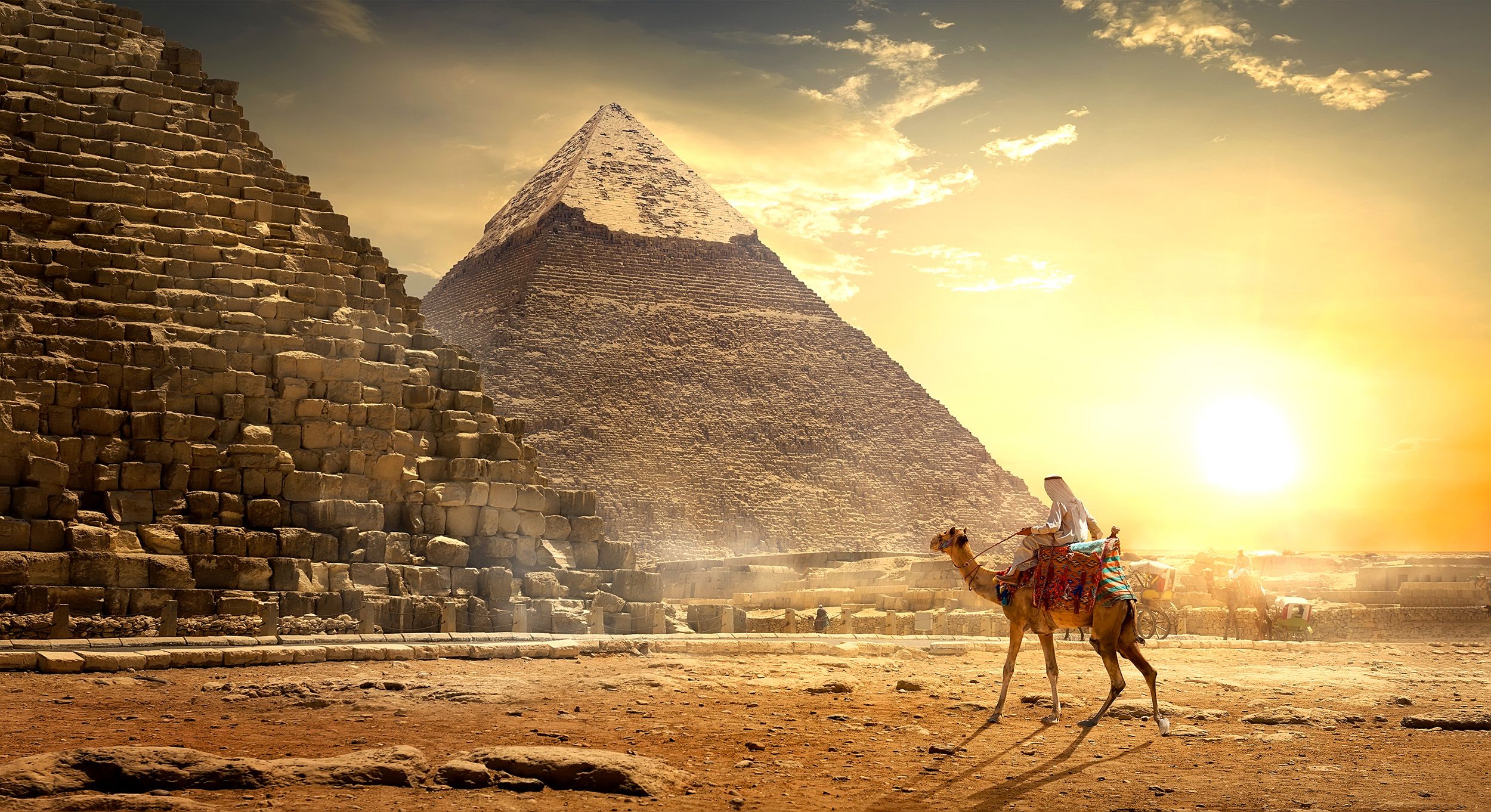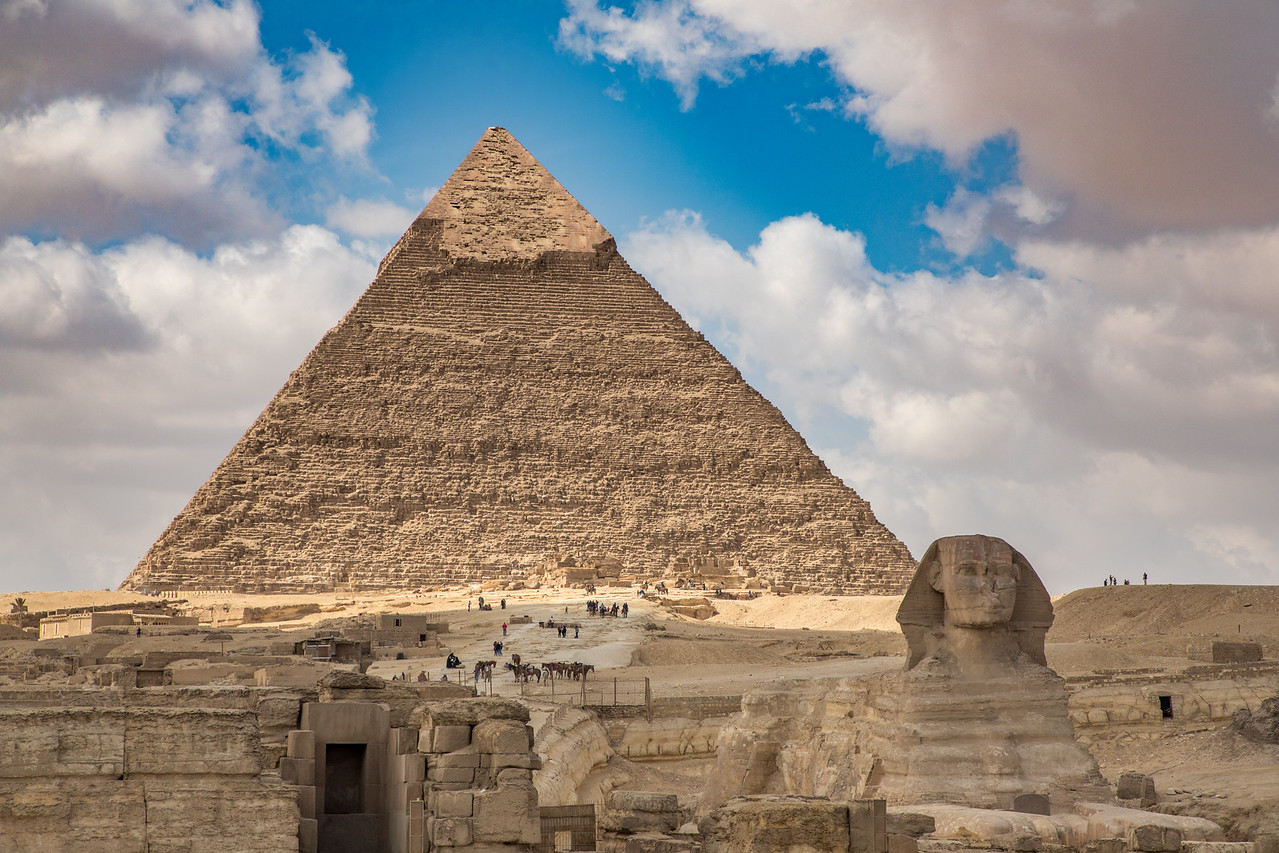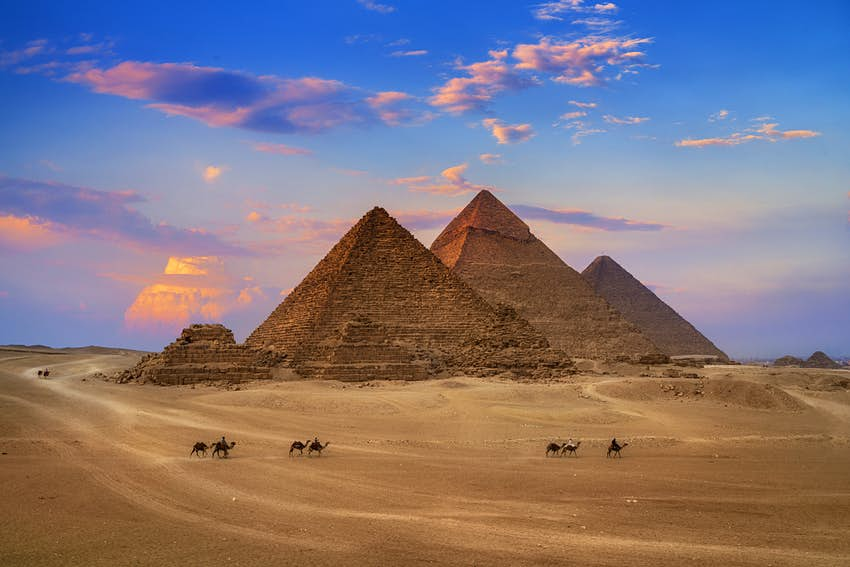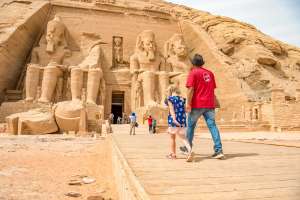The pyramids of Egypt have long stood as one of humanity’s greatest enigmas. Even in ancient times, travelers, scholars, and conquerors were awed by their sheer size and mystery. Today, they continue to fascinate modern visitors—tourists who marvel at their grandeur, mathematicians who attempt to decipher their proportions, and archaeologists who tirelessly explore the secrets hidden within their stones. These monuments seem eternal, rising above the sands like messages from a civilization determined to outlast time itself.
Centuries before the iconic pyramids of Giza came into being, the early kings of Egypt were buried in rectangular tombs called mastabas. These low, bench-shaped structures were constructed from mudbrick or stone, marking the resting places of the first dynasties. Around 2780 B.C., during the reign of King Djoser, the architectural genius Imhotep—revered later as a god of wisdom—transformed the concept of the royal tomb forever. He conceived a structure unlike anything built before: six mastabas stacked one atop another, each smaller than the one beneath it. The result was a towering monument known as the Step Pyramid, which rose proudly above the west bank of the Nile at Saqqara near ancient Memphis.
The Step Pyramid was not just an innovative tomb but a complex of chambers and corridors. Deep within its heart lay the burial chamber of the king, while surrounding rooms were designed for offerings, storage, and ritual. It symbolized Egypt’s leap into architectural immortality—where engineering met divine ambition.
From Step Pyramid to True Pyramid
The evolution from the stepped form to the smooth-sided pyramid we know today took place during the reign of King Snefru, founder of Egypt’s Fourth Dynasty (circa 2680–2560 B.C.). Snefru’s architects experimented boldly with form and structure, paving the way for perfection.
At Meidum, Snefru first oversaw the construction of what began as a step pyramid. Later, it was filled in and encased with polished limestone to create a smooth exterior. Though time and erosion have since reduced it to ruins, it was the first real attempt to achieve the geometric purity that would define the Great Pyramids.
Nearby at Dahshur, another ambitious project began—the Bent Pyramid. Its lower section rises at a steep angle of over 51 degrees, but partway up, the slope changes dramatically to about 43 degrees. This bend has intrigued historians for centuries. Most scholars believe that engineers, realizing the original angle threatened the pyramid’s stability, altered it mid-construction to prevent collapse. The result was a curious hybrid—halfway between step and true pyramid—but a crucial learning step in Egypt’s architectural evolution.
A short distance away, Snefru commissioned yet another masterpiece: the Red Pyramid at Dahshur. Its sides rise evenly at a consistent 43-degree angle, creating Egypt’s first true smooth-sided pyramid. Though slightly squat in appearance, the Red Pyramid represents the final refinement of the techniques that would culminate in the Great Pyramid of Giza.
The Great Pyramid and the Golden Age of Construction
Snefru’s experiments bore magnificent fruit in the reign of his son, King Khufu—known to the Greeks as Cheops—who built the largest and most famous of them all: the Great Pyramid of Giza. This structure is the pinnacle of ancient Egyptian engineering. Covering more than thirteen acres at its base, each of its four sides measured roughly 755 feet in length, rising originally to an astonishing height of over 481 feet. Even today, after millennia of erosion and loss of its polished casing stones, it still reaches about 450 feet—an architectural feat that dominated the world’s skyline for nearly four thousand years.
The precision of Khufu’s pyramid continues to baffle modern engineers. Each massive limestone block—averaging over two tons and some weighing as much as fifteen—was fitted so closely that even a blade cannot slide between them. The accuracy of its alignment to true north is unmatched even by many modern constructions.
Khufu’s son, Khafre, built his own pyramid nearby, slightly smaller but strategically placed on higher ground, giving the illusion that it is taller than his father’s. The complex of Khafre also includes the majestic Sphinx—an immense statue of a lion with the face of a pharaoh, thought to represent Khafre himself. The Sphinx guards the Giza Plateau, a symbol of royal power and divine protection. A third pyramid, belonging to Menkaure, stands nearby, more modest in scale but equally elegant in design.
Life, Ritual, and Mystery Around the Pyramids
The pyramids were not isolated monuments but the focal points of vast ceremonial complexes. Each was surrounded by temples, chapels, and subsidiary tombs belonging to nobles and priests. Enclosing walls marked sacred boundaries, and long causeways connected the pyramids to valley temples on the banks of the Nile. These temples likely served as the site where the king’s body was prepared for its journey into eternity.
Ancient records are scarce, but inscriptions and archaeological evidence provide glimpses of the rituals surrounding royal burials. It is believed that after death, the pharaoh’s body was transported by boat along the Nile to the pyramid complex. There, priests performed purification and mummification rites—perhaps in the Valley Temple—before entombing the ruler in his pyramid.
At Giza, archaeologists have unearthed the remains of large funerary boats, one of which was discovered disassembled but perfectly preserved. It was reassembled in modern times, revealing the incredible craftsmanship of Old Kingdom shipbuilders. These boats symbolized the pharaoh’s voyage to the afterlife, sailing with the sun god Ra across the heavens.
Inside many pyramids of the Fifth and Sixth Dynasties, walls are inscribed with the Pyramid Texts, a collection of spells and hymns meant to guide the deceased ruler through the afterlife. These inscriptions form one of the oldest known religious texts in human history, shedding light on the Egyptians’ complex beliefs about life, death, and divine order.
Yet despite centuries of study, much about the pyramid complexes remains mysterious. The precise methods of burial, the symbolic meanings of certain chambers, and the rituals performed within still puzzle scholars. Each discovery answers one question only to raise another, keeping the pyramids alive in the human imagination.
Who Built the Egyptian Pyramids?
For centuries, myths and misconceptions clouded the truth about who actually built these timeless monuments. One of the most persistent legends claims that slaves—oppressed, beaten, and forced into endless toil—constructed the pyramids under the lash of their masters. This idea, rooted in misreadings of ancient texts and reinforced by Hollywood epics, has been thoroughly debunked by modern archaeology.
In reality, the pyramids were the work of a skilled and organized labor force—people who took immense pride in what they were building. Excavations led by archaeologists such as Mark Lehner and Zahi Hawass have uncovered an entire city of workers near the Giza plateau. These findings reveal that the laborers were not enslaved but rather specialized teams who worked in rotation, well-fed, well-housed, and part of an extraordinary national effort.
Ancient graffiti discovered at the site identifies groups with names like “Friends of Khufu” and “Drunkards of Menkaure,” suggesting camaraderie and pride rather than oppression. These workers were organized in teams, much like modern construction crews, each responsible for specific tasks—from quarrying limestone to hauling, cutting, and positioning stones with remarkable precision.
Archaeologists have found enormous quantities of animal bones—cattle, sheep, and goats—at the site, enough to feed thousands daily. This evidence shows that workers were nourished like elites, their contribution celebrated as a patriotic duty. Nearby cemeteries discovered at the foot of the pyramids contain the graves of these laborers, buried with care and respect. Those who died during construction were honored close to the monument they helped create—a resting place worthy of heroes.
The Workforce Behind the Pyramids
The laborers who built the pyramids were not enslaved captives but citizens fulfilling a sacred duty to their country and their king. This concept, known in ancient Egypt as bak, was a form of service owed to the state—a civic obligation rather than forced servitude. It was similar in spirit to a massive community project or a collective contribution, where everyone worked toward honoring the divine authority of the pharaoh. For many, this service was not only expected but deeply respected.
Archaeologist Mark Lehner often compares it to the sense of duty found in tight-knit communities today—something akin to an Amish barn raising but on an unimaginable scale. Workers were called upon from across Egypt, forming rotating crews that might work for months before returning home to their farms. They were fed, housed, and treated fairly, an arrangement that was both pragmatic and symbolic of unity. The pyramids, then, were not simply royal tombs—they were a national achievement, an expression of shared belief that the king’s eternal life would sustain the cosmic order for all.
The work itself was brutally hard and at times dangerous. Injuries were common, and the heat of the desert made even small tasks exhausting. Yet, to the ancient Egyptians, participating in pyramid construction was a form of devotion. In exchange for their labor, they gained honor and a sense of belonging to something that transcended their individual lives. When they died, some were buried near the very monuments they helped raise—testament to the respect and gratitude they earned from their society.
Modern Excavations and What They Reveal
The discoveries made at Giza have transformed our understanding of how these colossal structures were built. The excavations led by Lehner and his colleague Zahi Hawass revealed worker villages complete with bakeries, breweries, storage rooms, and even medical facilities. These were not crude camps but organized, functioning communities capable of supporting thousands of laborers and artisans.
Massive quantities of bones found on-site tell us the workers were well-fed. Cattle, sheep, and goat remains show a diet rich in protein—hardly the rations of slaves. Large ovens and bread molds unearthed in the ruins confirm that bread and beer, staples of the Egyptian diet, were produced in astonishing volumes.
Even more telling were the inscriptions found within these villages. Names of work gangs—like “The Friends of Khufu” and “The Drunkards of Menkaure”—reflect a sense of pride and humor among the workers. Their graffiti immortalized them, suggesting that these men viewed their task as something monumental not just for the king but for history itself.
Nearby, archaeologists discovered workers’ cemeteries at the base of the pyramids. The bodies were carefully buried, often with jars of beer or bread—offerings for the afterlife. These graves prove the laborers were honored in death. Their resting places lie within sight of the massive stone structures they helped construct, as if keeping eternal watch over their creation.
Dispelling the Myths
The idea that the pyramids were built by slaves has endured for centuries, reinforced by religious interpretations, 19th-century speculation, and Hollywood films. But modern archaeology has stripped away these myths. The construction of the pyramids represents not oppression but cooperation, not brutality but ingenuity.
This revelation also dismantles another popular myth: that extraterrestrial beings or lost advanced civilizations were responsible. Such theories arise from an underestimation of ancient Egyptian intellect. In truth, these people possessed deep knowledge of geometry, physics, and astronomy. They didn’t need alien intervention; their achievements were human—rooted in discipline, skill, and divine motivation.
When you study the logistics of the Great Pyramid’s construction, you see an organized society capable of executing one of the most ambitious engineering projects in history. Each stone block, precisely measured and placed, speaks to method rather than mystery. Their work ethic and devotion transformed limestone and granite into eternal symbols of human will.
The Engineering Genius of the Ancient Builders
Recent studies and experiments have helped demystify how these colossal structures were actually built. Archaeologists and engineers agree that ancient Egyptians possessed all the necessary tools and techniques to accomplish the feat. They had no steel or iron—only copper—but their mastery of stonework compensated for the limitation.
Copper chisels, hammers, and saws were used to cut and shape the limestone blocks. Workers likely used wooden sleds to transport these blocks from nearby quarries to the construction site. One of the most remarkable discoveries is the evidence of a unique ramp system uncovered by Egyptologists from the University of Liverpool. This structure, featuring a central ramp flanked by staircases and holes for wooden posts, may have served as a pulley-assisted system to haul massive stones upward.
This design would have allowed teams to pull heavy blocks at steep angles using ropes and wooden sledges, gradually stacking layer upon layer until the pyramid took shape. Modern experiments replicating ancient methods suggest that a labor force of around 1,200 to 1,500 people could have achieved the same results—moving millions of stones over two decades.
Even the sourcing of materials demonstrates remarkable organization. The limestone used for the pyramid’s outer casing came from nearby quarries, while the granite for the inner chambers was transported from Aswan—over 600 miles away. The logistics required to move these stones without wheels or machinery is staggering, yet entirely achievable using sledges, lubricated sand, and sheer coordination.
Tools, Time, and Precision
To grasp the magnitude of this achievement, imagine the workers quarrying and transporting an Olympic-sized pool’s worth of stone roughly every eight days—continuously for over two decades. They did this not with modern cranes or engines but with ingenuity, teamwork, and persistence. The Egyptians’ ability to plan and execute on such a scale speaks volumes about their understanding of mathematics and their mastery of logistics.
They knew how to align their pyramids precisely with the cardinal directions, despite lacking compasses. They understood how to measure right angles, create perfectly level foundations, and calculate slopes that would hold steady under massive weight. This knowledge, passed through generations of builders, formed a tradition of craftsmanship that turned abstract belief into monumental form.
The copper tools they relied on may seem primitive, but when used with sand as an abrasive and water for cooling, they could cut through stone with surprising efficiency. Workers carved the stones to fit so precisely that the joints are barely visible even today. Their precision was not just technical—it was spiritual. For Egyptians, every perfect angle and alignment was a gesture of reverence toward the gods.
The Legacy of Human Ingenuity
In the end, the pyramids are more than royal tombs or tourist icons—they are a declaration of what humanity can achieve with shared purpose and imagination. Each block laid at Giza, Dahshur, and Saqqara represents a blend of devotion, intellect, and physical endurance.
Modern archaeology continues to uncover new details about how they were built, yet some mysteries endure—the full layout of worker settlements, the exact sequence of construction, the symbolic design of the internal chambers. But what is certain is that these monuments were created not through slavery or alien technology, but through the effort of tens of thousands of proud Egyptians working together under the gaze of their gods and kings.
The pyramids stand as proof that human creativity, when united with faith and determination, can literally move mountains. Over 4,000 years later, they still command awe—not as relics of a lost civilization, but as eternal reminders of human brilliance carved in stone.





















